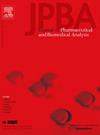CE-MS 和 CE-MS/MS 在亚基水平上对单克隆抗体变体进行多属性分析。
IF 3.1
3区 医学
Q2 CHEMISTRY, ANALYTICAL
Journal of pharmaceutical and biomedical analysis
Pub Date : 2024-10-01
DOI:10.1016/j.jpba.2024.116495
引用次数: 0
摘要
产品相关物质和杂质分析是多属性单克隆抗体(mAbs)生物制药质量控制的关键步骤,因为翻译后修饰或其他变体会影响产品的生物活性。目前有许多方法可用于变异体分析,但这些方法要么针对特定变异体,要么针对特定 mAb,要么耗时长,要么需要昂贵的设备。在此,我们介绍一种基于中性涂层毛细管的通用毛细管电泳方法,该方法通过 nanoCEasy 接口与质谱(MS)联用,用于亚单位水平的 mAb 变异分析(经酶消化和还原的 mAb)。该方法可分离多种(i)尺寸变体(如糖基化变体)和(ii)电荷变体(如 c 端赖氨酸剪切)以及(iii)多种其他蛋白形式(如额外糖化)和(iv)未完全还原的亚单位。即使是质量偏差较小的变体,如脱氨或开放的二硫桥,也能通过 MS/MS 片段分析得到确认。该系统最初是为一种 mAb 开发的,后来用其他九种 IgG1 进行了测试,以显示该系统的普遍适用性。所介绍的多属性方法只需很少的样品制备和相对简单的分离设备,就能快速、详细地鉴定 mAb 变体,并分离出大量 mAb 变体。本文章由计算机程序翻译,如有差异,请以英文原文为准。
CE-MS and CE-MS/MS for the multiattribute analysis of monoclonal antibody variants at the subunit level
The analysis of product-related substances and impurities is a critical step in the biopharmaceutical quality control of multiattribute monoclonal antibodies (mAbs), as posttranslational modifications or other variants can influence the product's biological activity. Many approaches are available for variant analysis; however, they are either variant-specific, mAb-specific, time-consuming, or require expensive equipment. Here, we present a generic capillary electrophoretic method based on a neutral-coated capillary which was coupled to mass spectrometry (MS) via the nanoCEasy interface for mAb variant analysis at the subunit level (enzymatically digested and reduced mAb). The method enabled the separation of several (i) size variants (e.g. glycosylation variants) and (ii) charge variants (e.g. c-terminal lysin clipping) as well as (iii) multiple other proteoforms (e.g. additional glycation) and (iv) incompletely reduced subunits. Separated variants were confirmed by MS/MS fragmentation even for small mass deviations like deamidation or open disulfide bridges. The system, initially developed for one mAb, was tested with nine other IgG1s to show the general applicability of the system. The presented multiattribute method enables fast and detailed characterization of mAb variants with little sample preparation and relatively simple separation equipment enabling the separation of a large set of mAb variants.
求助全文
通过发布文献求助,成功后即可免费获取论文全文。
去求助
来源期刊
CiteScore
6.70
自引率
5.90%
发文量
588
审稿时长
37 days
期刊介绍:
This journal is an international medium directed towards the needs of academic, clinical, government and industrial analysis by publishing original research reports and critical reviews on pharmaceutical and biomedical analysis. It covers the interdisciplinary aspects of analysis in the pharmaceutical, biomedical and clinical sciences, including developments in analytical methodology, instrumentation, computation and interpretation. Submissions on novel applications focusing on drug purity and stability studies, pharmacokinetics, therapeutic monitoring, metabolic profiling; drug-related aspects of analytical biochemistry and forensic toxicology; quality assurance in the pharmaceutical industry are also welcome.
Studies from areas of well established and poorly selective methods, such as UV-VIS spectrophotometry (including derivative and multi-wavelength measurements), basic electroanalytical (potentiometric, polarographic and voltammetric) methods, fluorimetry, flow-injection analysis, etc. are accepted for publication in exceptional cases only, if a unique and substantial advantage over presently known systems is demonstrated. The same applies to the assay of simple drug formulations by any kind of methods and the determination of drugs in biological samples based merely on spiked samples. Drug purity/stability studies should contain information on the structure elucidation of the impurities/degradants.

 求助内容:
求助内容: 应助结果提醒方式:
应助结果提醒方式:


